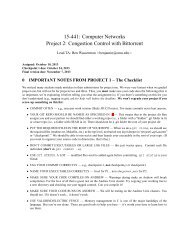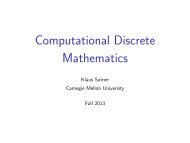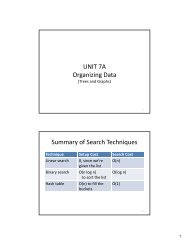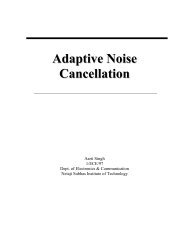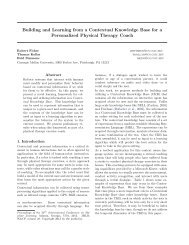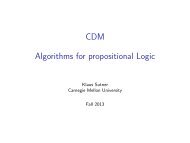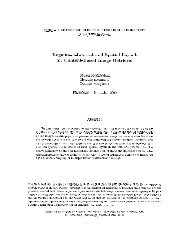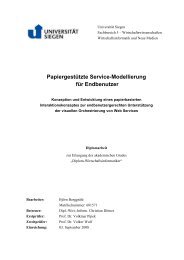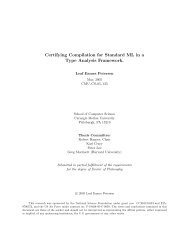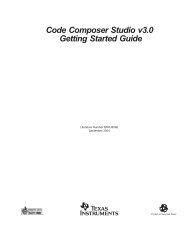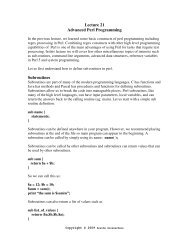Tinghui Zhou - School of Computer Science - Carnegie Mellon ...
Tinghui Zhou - School of Computer Science - Carnegie Mellon ...
Tinghui Zhou - School of Computer Science - Carnegie Mellon ...
Create successful ePaper yourself
Turn your PDF publications into a flip-book with our unique Google optimized e-Paper software.
<strong>Tinghui</strong> <strong>Zhou</strong><br />
Email: tinghuiz@cs.cmu.edu<br />
Phone: (612)860-1348<br />
Homepage: http://www.cs.cmu.edu/~tinghuiz/<br />
Education <strong>Carnegie</strong> <strong>Mellon</strong> University<br />
M. S. in Robotics (Expected Dec. 2012)<br />
Advisor: Alexei (Alyosha) Efros<br />
GPA: 4.0/4.0<br />
Research<br />
Interests<br />
Research<br />
Experience<br />
University <strong>of</strong> Minnesota-Twin Cities<br />
B. S. summa cum laude in <strong>Computer</strong> <strong>Science</strong> May 2011<br />
Major GPA: 3.95/4.0<br />
<strong>Computer</strong> Vision: scene and object recognition, image inpainting, image matching, datadriven<br />
image understanding<br />
Machine Learning: max-margin learning, transfer learning, matrix completion/factorization<br />
Robotics Institute, <strong>Carnegie</strong> <strong>Mellon</strong> University 09/2011 - Present<br />
Graduate Research Assistant with Alexei (Alyosha) Efros<br />
• Worked on the problem <strong>of</strong> learning general object models by exploiting the bias across differentimagedatasets.<br />
The proposedframeworkis discriminativeandbased onmax-margin<br />
learning. In particular, our model learns two sets <strong>of</strong> weights: bias vectors associated with<br />
each individual dataset, and weights that are common to all datasets, which are learned<br />
by undoing the associated bias from each dataset. The common weights are expected to<br />
be our best possible approximation to the object model trained on an unbiased dataset,<br />
thus tend to have good generalization ability.<br />
Disney Research, Pittsburgh 05/2012 - 08/2012<br />
Research Intern with Leonid Sigal<br />
• Worked on the problem <strong>of</strong> automated photo album creation from unordered image collections.<br />
The problem is difficult as it involves a number <strong>of</strong> complex perceptual tasks that<br />
facilitate selection and ordering <strong>of</strong> images to create a compelling visual narrative. To limit<br />
scope, we focus on vacation photographstaken at World Disney World by semi-pr<strong>of</strong>essional<br />
photographers. To capture and learn rules <strong>of</strong> album composition, we propose a discriminative<br />
structured model capable <strong>of</strong> encoding preferences for contextual layout <strong>of</strong> the scene<br />
(e.g., spatial layout <strong>of</strong> faces, global scene context, and landmark presence/absence) and ordering<br />
between photos (e.g., exclusion principles or correlations). Once learned, the model<br />
allows automatic composition <strong>of</strong> photo albums from unordered and untagged collections <strong>of</strong><br />
images. (This work has been submitted to CVPR, 2013.)<br />
<strong>Computer</strong> <strong>Science</strong> Department, University <strong>of</strong> Minnesota 09/2010-05/2011<br />
UROP with Arindam Banerjee and Guillermo Sapiro<br />
• Proposed a new matrix completion algorithm, i.e. Kernelized Probabilistic Matrix Factorization<br />
(KPMF), which effectively incorporates external side information into the matrix<br />
factorization process. KMPF explicitly captures the underlying (nonlinear) covariance<br />
structures across rows and columns by working with latent vectors spanning all rows (and<br />
columns) with Gaussian Process (GP) priors. Furthermore, GP priors allow the KPMF<br />
model to fill in a row (or column) that is entirely missing in the original matrix based on<br />
the sideinformationalone, whichis not feasiblefor standardPMF formulation. We demonstrate<br />
the efficacy <strong>of</strong> KPMF through two different applications: recommender systems and<br />
image restoration.
Center for Distributed Robotics, University <strong>of</strong> Minnesota 01/2010-05/2011<br />
Undergraduate Research Assistant with Nikolaos Papanikolopoulos<br />
• Worked on a long-term researchproject bringing together domain knowledge from psychiatry,<br />
computer vision, and machine learningto automate the detection <strong>of</strong>mental illness with<br />
childhood precursors (e.g. autism). To achieve this, we built a full 3-D monitoring system<br />
with multiple Kinect sensors. The use <strong>of</strong> multiple views significantly reduces the impact<br />
<strong>of</strong> occlusion when performing human tracking and motion analysis in cluttered scenes.<br />
• Presented a complete solution to the real-time simultaneous localization and mapping<br />
with a hand-held RGB+Range sensor. At each time step, the sensor gives two types <strong>of</strong><br />
measurements: an RGB image taken from a standard camera and an associated depth map<br />
from the range sensor. By utilizing both the color and depth information, the system is<br />
able to localize itself with respect to a predefined world coordinate frame and reconstruct<br />
a realistic 3D model <strong>of</strong> the environment.<br />
• Developed an algorithm for efficient detection <strong>of</strong> mutually-occluded ellipses. Randomized<br />
Hough transform (RHT) is known for its computational efficiency in ellipse detection.<br />
However, it performs poorly if the target ellipses are mutually-occluded. We developed an<br />
RHT extension that utilizes K-means clustering to improve its accuracy and efficiency in<br />
detecting mutually-occluded ellipses.<br />
Publications A. Khosla, T. <strong>Zhou</strong>, T. Malisiewicz, A. A. Efros, and Antonio Torralba, “Undoing the Damage<br />
<strong>of</strong> Dataset Bias,” European Conference in <strong>Computer</strong> Vision (ECCV), 2012.<br />
Leadership<br />
Activities<br />
Programming<br />
Skills<br />
Selected<br />
Awards<br />
T. <strong>Zhou</strong>, H. Shan, A. Banerjee, and G. Sapiro, “Kernelized Probabilistic Matrix Factorization:<br />
Exploiting Graphs and Side Information,”SIAM International Conference on Data Mining<br />
(SDM), 2012.<br />
T. <strong>Zhou</strong> and N. Papanikolopoulos, “Enhancing Randomized Hough Transform with K-Means<br />
Clustering to Detect Mutually-Occluded Ellipses,” Proceedings <strong>of</strong> the 19th Mediterranean Conference<br />
on Control and Automation (MED), 2011.<br />
Board Member <strong>of</strong> A-PACE 09/2012-Present<br />
• Co-organized discussion panels and invited talks for the Association <strong>of</strong> Pittsburgh Area<br />
Chinese Entrepreneurs (A-PACE), which seeks to provide a platform for Chinese students<br />
in Pittsburgh, especially those from CMU and University <strong>of</strong> Pittsburgh, to exchange entrepreneurial<br />
ideas and establish potential collaborations.<br />
Coordinator <strong>of</strong> Technology Day Camp 08/2010<br />
• Served as a coordinator <strong>of</strong> the annual Technology Day Camp hosted by the Center for Distributed<br />
Robotics at UMN. The mission <strong>of</strong> this event is to introduce the latest technology<br />
development to underprivileged youth in the Minneapolis/St. Paul area.<br />
Languages: C/C++, Matlab, Lisp, HTML, MIPS assembly<br />
Libraries and Tools: OpenGL, OpenCV, L ATEX, LIBSVM, Aria, Player/Stage,MobileSim, GDB,<br />
Subversion, Mobile Robot Programming Toolkit.<br />
UROP Award University <strong>of</strong> Minnesota 2011<br />
IT Merit Scholarship University <strong>of</strong> Minnesota 2010<br />
IMA MCM Meritorious Winner University <strong>of</strong> Minnesota 2010<br />
Summer Undergraduate Research Fellowship Purdue University 2010<br />
University Honors Program University <strong>of</strong> Minnesota 2009



